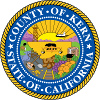- Kern County Gateway |
- Datasets |
- Kern County Farmland Mapping and Monitoring Program FMMP 2016
Kern County Farmland Mapping and Monitoring Program FMMP 2016
Feb 1, 2018
Uploaded by
Emily Leslie
- Description:
- Last updated: 2016.
Accessed online at the following URL on February 1, 2018:
http://www.conservation.ca.gov/dlrp/fmmp/products/Pages/DownloadGISdata.aspx
Abstract: Established in 1982, Government Code Section 65570 mandates FMMP to biennially report on the conversion of farmland and grazing land, and to provide maps and data to local government and the public.
Purpose: The Farmland Mapping and Monitoring Program (FMMP) provides data to decision makers for use in planning for the present and future use of California's agricultural land resources. The data is a current inventory of agricultural resources. This data is for general planning purposes and has a minimum mapping unit of ten acres.
Definitions of FMMP Types:
Prime Farmland (P): Irrigated land with the best combination of physical and chemical features able to sustain long term production of agricultural crops. This land has the soil quality, growing season, and moisture supply needed to produce sustained high yields. Land must have been used for production of irrigated crops at some time during the four years prior to the mapping date.
Farmland of Statewide Importance (S): Irrigated land similar to Prime Farmland that has a good combination of physical and chemical characteristics for the production of agricultural crops. This land has minor shortcomings, such as greater slopes or less ability to store soil moisture than Prime Farmland. Land must have been used for production of irrigated crops at some time during the four years prior to the mapping date.
Unique Farmland (U): Lesser quality soils used for the production of the state's leading agricultural crops. This land is usually irrigated, but may include non-irrigated orchards or vineyards as found in some climatic zones in California. Land must have been cropped at some time during the four years prior to the mapping date.
Farmland of Local Importance (L): The Board of Supervisors determined that there will be no Farmland of Local Importance for Kern County.
Grazing Land (G): Land on which the existing vegetation is suited to the grazing of livestock. This category is used only in California and was developed in cooperation with the California Cattlemen's Association, University of California Cooperative Extension, and other groups interested in the extent of grazing activities.
Urban and Built-Up Land (D): Urban and Built-Up land is occupied by structures with a building density of at least 1 unit to 1.5 acres, or approximately 6 structures to a 10-acre parcel. Common examples include residential, industrial, commercial, institutional facilities, cemeteries, airports, golf courses, sanitary landfills, sewage treatment, and water control structures.
Other Land (X): Land which does not meet the criteria of any other category. Typical uses include low density rural development, heavily forested land, mined land, or government land with restrictions on use. This category was subdivided into R, V, Cl, sAC, and nv beginning with the 2006 data.
Water (W): Water areas with an extent of at least 40 acres.
Area not mapped (Z): Area which falls outside of the NRCS soil survey. Not mapped by the FMMP.
Irrigated Farmland (I): Cropped land with a developed irrigation water supply that is dependable and of adequate quality. Land must have been used for production of irrigated crops at some time during the four years prior to the mapping date. Irrigated farmland is considered an 'Interim' category for use until completion of USDA-NRCS soil surveys. (The Irrigated Farmland category is only used in specific agricultural counties lacking modern soil surveys. It is applicable for Southwestern and Northeastern Kern County for 1988-2002 data. It was upgraded to Important Farmland status in 2004 upon completion of the following NRCS soil surveys (CA668) (CA669) (CA682) (CA691) (CA760) (CA772).)
Non-irrigated Farmland (N): Land on which agricultural commodities are produced on a continuing or cyclic basis utilizing stored soil moisture. Non-Irrigated Farmland is considered an 'Interim' category for use until completion of USDA-NRCS soil surveys. (The Non-Irrigated Farmland category is only used in specific agricultural counties lacking modern soil surveys. It is applicable for Southwestern and Northeastern Kern County for 1988-2002 data. It was upgraded to Important Farmland status in 2004 upon completion of the following NRCS soil surveys (CA668) (CA669) (CA682) (CA691) (CA760) (CA772))
Rural Residential Land (R): This includes residential areas of one to five structures per ten acres.
Vacant or Disturbed Land (V): This consists of open field areas that do not qualify for an agricultural category, mineral and oil extraction areas, and rural freeway interchanges.
Confined Animal Agriculture (Cl): This includes aquaculture, dairies, feedlots, and poultry facilities
Nonagricultural and Natural Vegetation (nv): This covers heavily wooded, rocky or barren areas, riparian and wetland areas, grassland areas which do not qualify for Grazing Land due to their size or land management restrictions, and small water bodies. Constructed wetlands are also included in this category.
Semi-Agricultural and Rural Commercial Land (sAC): This includes farmsteads, agricultural storage and packing sheds, unpaved parking areas, composting facilities, equine facilities, firewood lots, and campgrounds.
- Data Provided By:
- California Department of Conservation, Division of Land Resource Protection, Farmland Mapping and Monitoring Program
- Content date:
- not specified
- Spatial Resolution:
- 10 acres
- Contact Organization:
- not specified
- Contact Person(s):
- not specified
- Use Constraints:
- This data does not reflect general plan or zoning designations, city limit lines, changing economic or market conditions, or other factors which may be taken into consideration when land use policies are determined. This data is not designed to be used for parcel specific planning purposes due to its scale and the size of the minimum mapping unit (10 acres). The Department of Conservation makes no warranties as to the suitability of this data for any particular purpose.
- Layer:
- Layer Type:
- Currently Visible Layer:
- All Layer Options:
- Layers in this dataset are based on combinations of the following options. You may choose from these options to select a specific layer on the map page.
- Description:
- Spatial Resolution:
- Credits:
- Citation:
- Purpose:
- Methods:
- References:
- Other Information:
- Time Period:
- Layer Accuracy:
- Attribute Accuracy:
FGDC Standard Metadata XML
Click here to see the full FGDC XML file that was created in Data Basin for this layer.
Original Metadata XML
Click here to see the full XML file that was originally uploaded with this layer.
This dataset is visible to everyone
- Dataset Type:
-
Layer Package
Downloaded by
5 Members
Included in
2 Public Maps
,
32 Private Maps
About the Uploader




